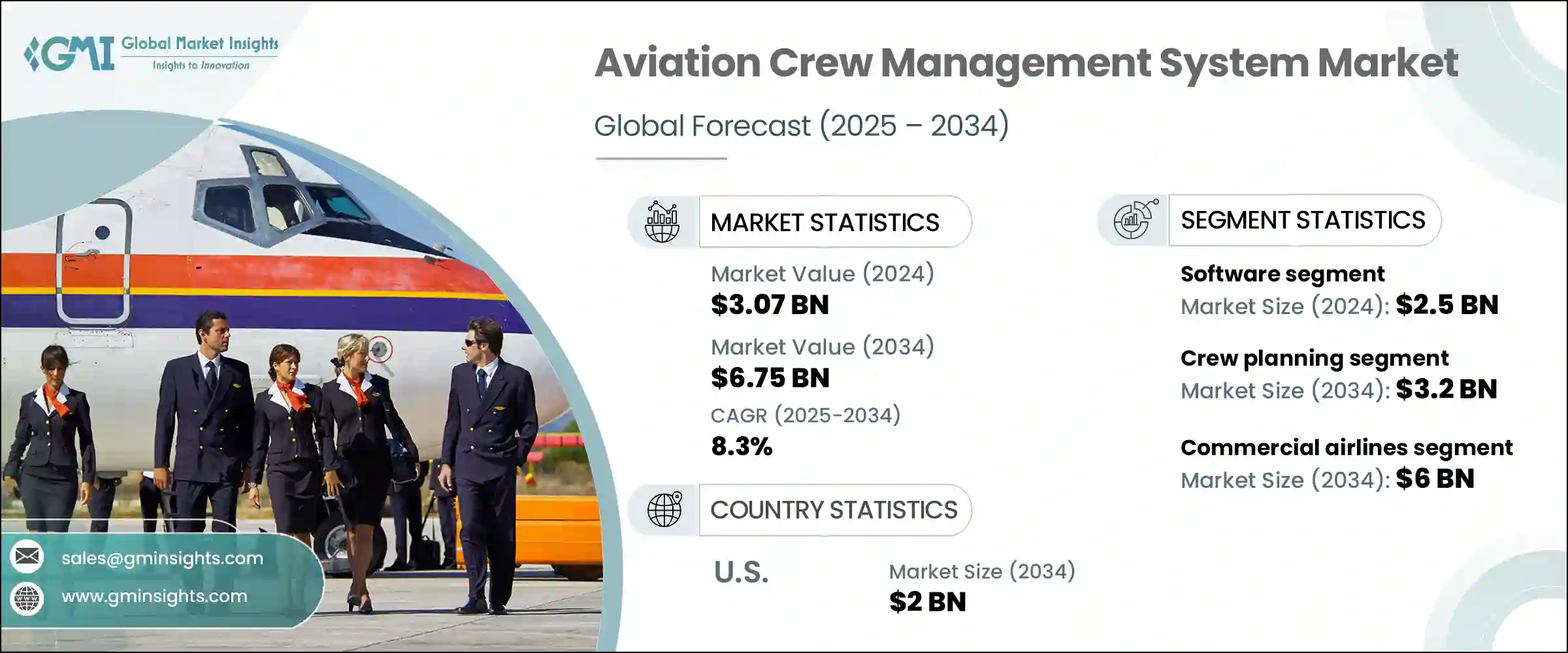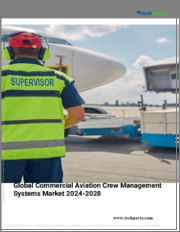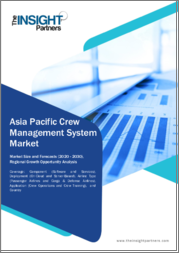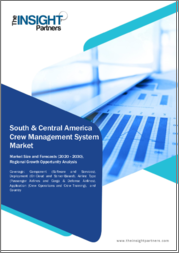
|
시장보고서
상품코드
1773420
세계의 항공 승무원 관리 시스템 시장 기회, 성장 촉진요인, 산업 동향 분석 및 예측(2025-2034년)Aviation Crew Management System Market Opportunity, Growth Drivers, Industry Trend Analysis, and Forecast 2025 - 2034 |
||||||
항공 승무원 관리 시스템 세계 시장은 2024년에는 30억 7,000만 달러로 평가되었고, CAGR 8.3%로 성장하여 2034년에는 67억 5,000만 달러에 이를 것으로 예측됩니다.
2043년까지 연간 3.8%의 항공 여객 증가가 예상되는 가운데, 항공기 대형화와 운항 스케줄의 과밀화에 대응하기 위해 고급 승무원 스케줄링 툴의 필요성이 높아지고 있습니다.

기존의 스케줄링 방식으로는 오늘날의 복잡한 운항 상황을 감당할 수 없습니다는 사실이 밝혀지면서 항공사들은 점점 더 자동화된 승무원 관리 시스템으로 눈을 돌리고 있습니다. 이러한 플랫폼은 실시간 업데이트, 효율적인 자원 배분, 관리 실수 감소, 마지막 순간 승무원 변경에 대한 신속한 대응을 가능하게 합니다. 또한, 비행 안전, 운항 규정 준수, 승무원 복리후생에 대한 관심이 높아지면서 채용이 더욱 가속화되고 있습니다.
| 시장 범위 | |
|---|---|
| 개시 연도 | 2024년 |
| 예측 연도 | 2025-2034년 |
| 개시 금액 | 30억 7,000만 달러 |
| 예측 금액 | 67억 5,000만 달러 |
| CAGR | 8.3% |
세계 무역 정책의 변화는 수입 항공 기술의 가격과 가용성에 영향을 미치고 있으며, IT 인프라와 수입 소프트웨어에 대한 새로운 관세로 인해 승무원 관리 플랫폼의 구축 및 유지보수 비용이 증가하고 있습니다. 이에 대응하기 위해 항공사들은 탄력성과 규제 준수를 보장하기 위해 지역 및 현지 개발 솔루션으로 눈을 돌리고 있습니다.
국내 또는 지역 생산 소프트웨어에 투자함으로써 기업은 국제 무역의 변화 및 사이버 보안에 대한 노출과 관련된 위험을 줄이면서 중단 없는 운영과 장기적인 비용 효율성을 유지할 수 있습니다. 이러한 변화는 전략적 디지털 전환의 목표에 부합하는 동시에 소프트웨어 생태계를 보다 로컬화하여 소프트웨어 생태계를 더욱 로컬화합니다. 승무원의 피로에 대한 우려가 높아지면서 피로 모니터링 기능을 시스템에 통합하는 항공사가 증가하고 있습니다. 항공 안전 규제 당국은 위험도가 높은 스케줄을 예측하고 회피할 수 있도록 지원하는 피로 위험 관리 시스템(FRMS)에 더 많은 관심을 기울이고 있습니다.
2024년에는 소프트웨어 부문이 25억 달러로 평가되어 가장 큰 시장 점유율을 차지할 것으로 예측됩니다. 항공사들은 실시간 스케줄링, 사전 피로 추적, 승무원 커뮤니케이션 강화를 제공하는 인공지능 강화 소프트웨어에 빠르게 투자하고 있습니다. 항공 업무가 점점 더 복잡해짐에 따라, 이러한 지능형 플랫폼은 더 나은 비즈니스 의사결정, 더 효율적인 인력 관리, 더 큰 규제 준수를 가능하게 하고 있습니다. 이러한 소프트웨어 솔루션은 인적 오류를 줄이고 자동화를 촉진함으로써 현대 항공 업무에 필수적인 요소로 자리 잡고 있습니다.
승무원 계획 분야는 최적화된 스케줄링 및 근무 시간 관리에 대한 수요 증가에 힘입어 2034년까지 32억 달러 규모 시장을 창출할 것으로 예측됩니다. 항공사의 사업 규모가 확대됨에 따라 노동 기준을 준수하면서 자원 배분을 지능적으로 처리할 수 있는 AI 기반 계획 시스템에 대한 중요성이 커지고 있습니다. 승무원 계획 모듈은 스케줄 충돌을 방지하고 다운타임을 줄이는 데 사용되어 항공사가 정시성을 유지하고 승무원의 성과를 향상시키는 데 도움을 주고 있습니다. 이러한 예측 도구는 지연을 최소화하고 전체 항공기의 운항 흐름을 개선하는 데 필수적인 역할을 하고 있습니다.
미국 항공 승무원 관리 시스템 시장은 2034년까지 20억 달러에 달할 것으로 예측됩니다. 이 지역의 성장 원동력은 안전에 중점을 둔 규제와 인프라 개선입니다. 규제 당국이 항공 부문 전반에 걸쳐 안전 관리 프레임워크를 요구함에 따라 첨단 승무원 관리 플랫폼에 대한 수요가 증가하고 있습니다. 항공 교통 인프라 및 인력 배치에 대한 투자 증가는 원활한 승무원 조정의 필요성을 더욱 높이고 있으며, IoT 및 인공지능과 같은 스마트 기술의 통합은 시스템의 반응성을 향상시키고 항공 운영을 보다 안전하고 효율적으로 만들어 미국 항공 부문의 디지털 전환을 촉진하고 있습니다. 강화하고 있습니다.
경쟁 구도를 형성하는 주요 업체로는 Lufthansa Systems, CAE Inc, IBS Software, PDC, Jeppesen 등이 있습니다. 주요 승무원 관리 시스템 제공업체들은 AI 통합, 전략적 제휴, 지역 확장 등을 통해 시장 내 입지를 강화하고 있습니다. 이들은 지능형 스케줄링 시스템 및 피로 예측 도구에 투자하여 운영 가시성을 개선하고 컴플라이언스 리스크를 줄이기 위해 노력하고 있습니다.
또한, 기존 항공사의 인프라와 원활하게 통합되는 모듈식 플랫폼을 구축하여 도입의 용이성을 보장하고 있습니다. 현지 항공사와의 전략적 파트너십을 통해 지리적 범위를 확장하고 지역 시장을 위한 맞춤형 서비스를 제공할 수 있습니다. 클라우드 기반 배포를 도입하고 확장 가능한 솔루션을 제공함으로써 벤더는 대형 항공사와 지역 항공사 모두에 대한 접근성을 높이고 있습니다.
목차
제1장 조사 방법과 범위
제2장 주요 요약
제3장 업계 인사이트
- 생태계 분석
- 트럼프 정권에 의한 관세에 대한 영향
- 무역에 대한 영향
- 무역량 혼란
- 보복 조치
- 업계에 대한 영향
- 공급측 영향(서비스 제공업체)
- 주요 서비스 가격 변동
- 공급망 재구축
- 생산비용에 대한 영향
- 수요측 영향(가격 결정)
- 최종 시장에의 가격 전달
- 시장 점유율 동향
- 소비자 반응 패턴
- 영향을 받는 주요 기업
- 전략적인 업계 대응
- 서버 프로바이더 재구성
- 가격 결정과 서비스 전략
- 정책 관여
- 전망과 향후 검토사항
- 공급측 영향(서비스 제공업체)
- 무역에 대한 영향
- 업계에 대한 영향요인
- 성장 촉진요인
- 업계의 잠재적 리스크&과제
- 성장 가능성 분석
- 규제 상황
- 기술 상황
- 향후 시장 동향
- 갭 분석
- Porter's Five Forces 분석
- PESTEL 분석
제4장 경쟁 구도
- 서론
- 기업의 시장 점유율 분석
- 주요 시장 기업의 경쟁 분석
- 경쟁 포지셔닝 매트릭스
- 전략 대시보드
제5장 시장 추산·예측 : 솔루션별, 2021년-2034년
- 주요 동향
- 소프트웨어
- 서비스
제6장 시장 추산·예측 : 용도별, 2021년-2034년
- 주요 동향
- 승무원 계획
- 승무원 추적
- 승무원 급여 및 보수 관리
- 기타
제7장 시장 추산·예측 : 최종 용도별, 2021년-2034년
- 주요 동향
- 상용 항공사
- 군 및 방위
제8장 시장 추산·예측 : 지역별, 2021년-2034년
- 주요 동향
- 북미
- 미국
- 캐나다
- 유럽
- 독일
- 영국
- 프랑스
- 스페인
- 이탈리아
- 아시아태평양
- 중국
- 인도
- 일본
- 호주 및 뉴질랜드
- 한국
- 라틴아메리카
- 브라질
- 멕시코
- 중동 및 아프리카
- 아랍에미리트(UAE)
- 사우디아라비아
- 남아프리카공화국
제9장 기업 개요
- AIMS INTL DWC LLC
- APD
- Awery Aviation Software
- Blue One Management S.A./N.V.
- BytzSoft Technologies Pvt.
- CAE Inc.
- FL3XX GmbH
- HITIT
- IBS Software
- Jeppesen
- Laminaar Aviation Infotech Pte Ltd.
- Leon Software
- Lufthansa Systems
- Maureva Ltd.
- NAVBLUE
- PDC
- Ramco Systems
- Takeflite
The Global Aviation Crew Management System Market was valued at USD 3.07 billion in 2024 and is estimated to grow at a CAGR of 8.3% to reach USD 6.75 billion by 2034. The increase in global passenger air traffic is playing a major role in boosting market demand. With projections indicating a 3.8% annual rise in airline passengers through 2043, there is a mounting need for advanced crew scheduling tools to meet the challenges of larger fleets and denser flight schedules.

As traditional scheduling methods prove inadequate for handling today's operational complexities, airlines are increasingly turning toward automated crew management systems. These platforms enable real-time updates, efficient resource allocation, reduced administrative errors, and quicker adaptation to last-minute crew changes. Additionally, the growing emphasis on flight safety, operational compliance, and crew well-being is further accelerating adoption.
| Market Scope | |
|---|---|
| Start Year | 2024 |
| Forecast Year | 2025-2034 |
| Start Value | $3.07 billion |
| Forecast Value | $6.75 billion |
| CAGR | 8.3% |
Changing global trade policies have influenced the pricing and availability of imported aviation technologies. New tariffs on IT infrastructure and imported software have raised the costs associated with deploying and maintaining crew management platforms. In response, aviation firms are pivoting toward regional and locally developed solutions to ensure resilience and regulatory compliance.
By investing in domestic or regional software, companies are mitigating risks related to international trade shifts and cybersecurity exposure while maintaining uninterrupted operations and long-term cost efficiency. This shift is aligning with strategic digital transformation goals while keeping software ecosystems more localized. Growing concerns around crew fatigue have also driven more airlines to integrate fatigue monitoring capabilities within their systems. Aviation safety regulators are placing greater importance on Fatigue Risk Management Systems (FRMS), which help forecast and avoid high-risk schedules.
In 2024, the software segment accounted for the largest share of the market, valued at USD 2.5 billion. Airlines are rapidly investing in artificial intelligence-enhanced software that offers real-time scheduling, proactive fatigue tracking, and enhanced crew communication. As aviation operations become more global and complex, these intelligent platforms are enabling better operational decision-making, more efficient workforce management, and greater regulatory adherence. By reducing human error and increasing automation, these software solutions are becoming indispensable in modern airline operations.
The crew planning segment is set to generate USD 3.2 billion by 2034, propelled by rising demand for optimized scheduling and duty time management. As airlines scale their operations, there's increasing emphasis on AI-driven planning systems that can handle resource distribution intelligently while adhering to labor standards. Crew planning modules are being used to prevent scheduling conflicts and reduce downtime, helping airlines maintain punctuality and boost crew performance. These predictive tools are becoming essential in minimizing delays and improving operational flow across fleets.
United States Aviation Crew Management System Market is expected to reach USD 2 billion by 2034. Growth in this region is driven by safety-focused regulations and infrastructure improvements. With regulatory authorities calling for safety management frameworks across aviation sectors, the demand for advanced crew management platforms is growing. Increased investment in air traffic infrastructure and staffing has further amplified the need for seamless crew coordination. Integration of smart technologies such as IoT and artificial intelligence is improving system responsiveness, making aviation operations safer and more efficient, and reinforcing the push toward digital transformation in the U.S. aviation sector.
Key players shaping the competitive landscape include Lufthansa Systems, CAE Inc., IBS Software, PDC, and Jeppesen. Leading aviation crew management system providers are strengthening their market positioning through a mix of AI integration, strategic collaborations, and regional expansion. They are investing in intelligent scheduling systems and fatigue prediction tools to improve operational visibility and reduce compliance risks.
These companies are also building modular platforms that integrate seamlessly with existing airline infrastructure, ensuring ease of adoption. Strategic partnerships with local aviation companies help expand their geographical reach and enable tailored offerings for regional markets. By incorporating cloud-based deployments and offering scalable solutions, vendors are enhancing accessibility for both large carriers and regional operators.
Table of Contents
Chapter 1 Methodology and Scope
- 1.1 Market scope and definitions
- 1.2 Research design
- 1.2.1 Research approach
- 1.2.2 Data collection methods
- 1.3 Base estimates and calculations
- 1.3.1 Base year calculation
- 1.3.2 Key trends for market estimation
- 1.4 Forecast model
- 1.5 Primary research and validation
- 1.5.1 Primary sources
- 1.5.2 Data mining sources
Chapter 2 Executive Summary
- 2.1 Industry 3600 synopsis
Chapter 3 Industry Insights
- 3.1 Industry ecosystem analysis
- 3.2 Trump administration tariffs
- 3.2.1 Impact on trade
- 3.2.1.1 Trade volume disruptions
- 3.2.1.2 Retaliatory measures
- 3.2.1.3 Impact on the industry
- 3.2.1.3.1 Supply-side impact (service providers)
- 3.2.1.3.1.1 Price volatility in key services
- 3.2.1.3.1.2 Supply chain restructuring
- 3.2.1.3.1.3 Production cost implications
- 3.2.1.3.2 Demand-side impact (pricing)
- 3.2.1.3.2.1 Price transmission to end markets
- 3.2.1.3.2.2 Market share dynamics
- 3.2.1.3.2.3 Consumer response patterns
- 3.2.1.3.3 Key companies impacted
- 3.2.1.3.4 Strategic industry responses
- 3.2.1.3.4.1 Server provider reconfiguration
- 3.2.1.3.4.2 Pricing and service strategies
- 3.2.1.3.4.3 Policy engagement
- 3.2.1.3.5 Outlook and future considerations
- 3.2.1.3.1 Supply-side impact (service providers)
- 3.2.1 Impact on trade
- 3.3 Industry impact forces
- 3.3.1 Growth drivers
- 3.3.1.1 Rising air traffic and fleet expansion
- 3.3.1.2 Increasing focus on operational efficiency
- 3.3.1.3 Integration of AI and automation technologies
- 3.3.1.4 Regulatory compliance and safety standards
- 3.3.1.5 Demand for real-time crew scheduling and optimization
- 3.3.2 Industry pitfalls and challenges
- 3.3.2.1 High implementation and maintenance costs
- 3.3.2.2 Data security and privacy concerns
- 3.3.1 Growth drivers
- 3.4 Growth potential analysis
- 3.5 Regulatory landscape
- 3.6 Technology landscape
- 3.7 Future market trends
- 3.8 Gap analysis
- 3.9 Porter's analysis
- 3.10 PESTEL analysis
Chapter 4 Competitive Landscape, 2024
- 4.1 Introduction
- 4.2 Company market share analysis
- 4.3 Competitive analysis of major market players
- 4.4 Competitive positioning matrix
- 4.5 Strategy dashboard
Chapter 5 Market Estimates & Forecast, By Solution, 2021-2034 (USD Billion)
- 5.1 Key trends
- 5.2 Software
- 5.3 Services
Chapter 6 Market Estimates & Forecast, By Application, 2021-2034 (USD Billion)
- 6.1 Key trends
- 6.2 Crew planning
- 6.3 Crew tracking
- 6.4 Crew payroll & compensation management
- 6.5 Others
Chapter 7 Market Estimates & Forecast, By End Use, 2021-2034 (USD Billion)
- 7.1 Key trends
- 7.2 Commercial airlines
- 7.3 Military & defense
Chapter 8 Market Estimates and Forecast, By Region, 2021 – 2034 (USD Billion)
- 8.1 Key trends
- 8.2 North America
- 8.2.1 U.S.
- 8.2.2 Canada
- 8.3 Europe
- 8.3.1 Germany
- 8.3.2 UK
- 8.3.3 France
- 8.3.4 Spain
- 8.3.5 Italy
- 8.4 Asia Pacific
- 8.4.1 China
- 8.4.2 India
- 8.4.3 Japan
- 8.4.4 ANZ
- 8.4.5 South Korea
- 8.5 Latin America
- 8.5.1 Brazil
- 8.5.2 Mexico
- 8.6 Middle East and Africa
- 8.6.1 UAE
- 8.6.2 Saudi Arabia
- 8.6.3 South Africa
Chapter 9 Company Profiles
- 9.1 AIMS INTL DWC LLC
- 9.2 APD
- 9.3 Awery Aviation Software
- 9.4 Blue One Management S.A. / N.V.
- 9.5 BytzSoft Technologies Pvt.
- 9.6 CAE Inc.
- 9.7 FL3XX GmbH
- 9.8 HITIT
- 9.9 IBS Software
- 9.10 Jeppesen
- 9.11 Laminaar Aviation Infotech Pte Ltd.
- 9.12 Leon Software
- 9.13 Lufthansa Systems
- 9.14 Maureva Ltd.
- 9.15 NAVBLUE
- 9.16 PDC
- 9.17 Ramco Systems
- 9.18 Takeflite

















